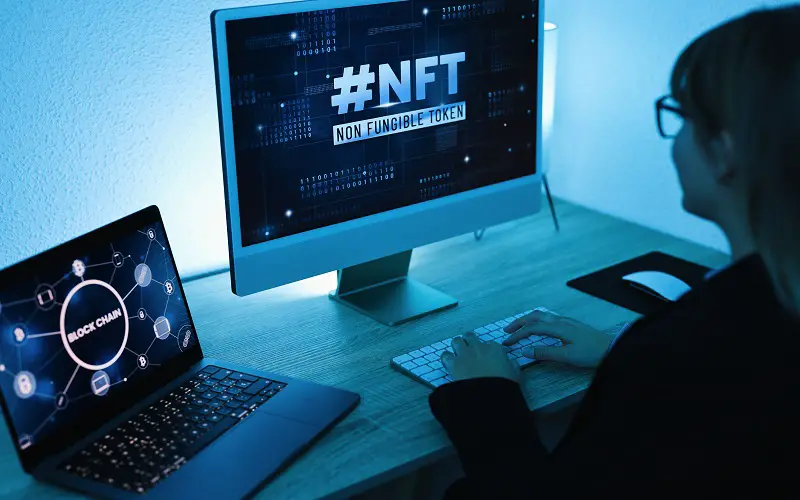You must be trying to familiarize yourself with NFTs, judging from how they have gained popularity in the last few months. These tokens have become a part-time source of income for several artists, digital creators and content creators. You should strive hard to understand their working mechanism if you haven’t.
You may have also noticed NFT enthusiasts, investors and creators use specific terms, slang, abbreviations and wordings when talking about these tokens. Well, you don’t have to float anymore during such discussions because this article will cover some of the most common NFT terms you will ever come across. Take a look at the following:
1. Gas
You have definitely heard people talk of gas and gas fees when talking about NFTs and wondered what they meant, or perhaps even read an article about the Ethereum Blockchain where the writer mentions excessive gas fees. What exactly is gas? Gas in NFT terms is different from the one science students are taught. Instead of being a state of matter, gas in NFTs refers to the cost of making a transaction on a blockchain.
Blockchains such as Solana have negligible gas fees, while others like Ethereum, which the OpenSea marketplace is built upon, have ridiculously high gas fees. You will part with $50 or more when minting an NFT on it and other associated blockchains. This fee usually depends on what you are doing on the network and further increases with many simultaneous transactions since high activity increases costs.
You will also bump on gas war, a popular term associated with gas fees. A gas war commonly occurs when creators launch an NFT collection that becomes famous. It is particularly upsetting for newcomers who must increase their gas fees to outbid other interested buyers. Therefore, please don’t look confused or startled when someone mentions gas fees, or you bump on it when researching NFTs.
2. Burn
Most people get surprised when NFT enthusiasts and creators talk about burning their tokens. Even though the term may not easily translate to the standard concept of burning that we all know, it is pretty close. Burning a non-fungible token means destroying it. This is a crazy idea that people are still trying to wrap their heads around, given that NFTs are incredibly precious and expensive. If it helps, burning creates scarcity and raises these tokens’ value.
Remember, an NFT becomes immutable after minting and uploading in the blockchain and will stay there permanently. However, burning steps in by sending the token to an inaccessible address and removing it from circulation. This doesn’t mean that the NFT will entirely cease to exist; it just makes it unavailable and therefore impossible to circulate.
NFTs thrive on scarcity, meaning that the lesser they circulate, the higher their value gets. A good example is the CryptoPunks project, which only has 1000NFTs in circulation amidst millions of NFT enthusiasts.
Investors introduced this burning concept since it is impossible to delete an NFT once uploaded to the blockchain.
3. Generative Art
Have you ever heard of generative art? Do you know what it entails? Generative art is a popular form of NFT art creation that has seen people make millions of dollars. It is an essential innovation in the NFT world and is responsible for some of the most successful collectables such as Cool cats, Bored Ape Yacht Club, Pudgy Penguins and Sup Ducks(You should be aware of either of these)
NFTs made through generative art have several common traits and are therefore easily recognizable. These can be their headwear, background colours, eye type and skin colour. You will notice a resemblance between the Bored Ape Yacht Club collectable and the Pudgy Penguins. Note that a creator can easily mix these traits to develop thousands of unique, distinct NFTs.
In generative art, the initial traits are generally handmade. The subsequent minting and replication process is computerized by randomly combining all the existing characteristics, explaining why it is called ‘generative’.
4. Metadata
This is another popular term when it comes to NFTs that you should know. We all know that they are unique, a quality that gives them their value. Therefore, the metadata of a non-fungible token refers to all the distinct and necessary pieces of information(data) that makes it what it is. It defines what an NFT or collectable looks like.
This is one of the reasons why OpenSea users at times have to refresh the metadata to allow them to see how newly minted NFTs look. The metadata can also be defined as the core of the NFT as it usually has its name, description, link to the hosted image and traits. Therefore, this should not be a wild concept in common NFT spaces.
Note that such information is necessary as it acts as your NFT smart contract’s input, which is then deployed on your blockchain. For OpenSea users, this will happen on the Ethereum network, making the token immutable.
5. Reveal
You must have noticed that most NFT terms are similar to our daily terms. Therefore, do not feel lost since they draw heavily from the latter. Reveal in NFT terms is closely related to what revelation means in our everyday speech, just that it has a different context.
When then does a reveal happen? It happens in new generative art projects, where the artwork only exists once the NFT has been minted, barring anyone from knowing or telling what it is until after the acquisition. In simple terms, the NFT only reveals after purchase. Nobody is allowed to access the NFTs traits before it is purchased. The creators have the liberty to choose whether this happens immediately after purchase or after some time, say 24 hours.
This is a pretty cool concept as it builds up anticipation and allows a buyer to be the first to witness their NFT. Do not, therefore, get shocked coming across a new NFT collection and its pre-reveal placeholder images.
6. PFP Project
Serious NFT investors and creators such as Jack Dorsey, who has made a fortune on NFTs in a short while, seem to be interested in PFPs. Therefore, the biggest question that arises among several NFT beginners is what PFPs are. PFP is an abbreviation for a profile picture.
How does a standard abbreviation end up becoming this popular? Well, these NFTs are made during PFP projects, same as 10k and avatar projects, and are mainly used as profile pictures. Most of them cause an arm and a leg, and only entrepreneurs, whales and investors can afford.
One of the most successful PFP projects was CryptoPunks, which saw the creation of 10000 unique characters by Larva Labs. They are generally used as profile pictures on Twitter, Discord and a range of other applications swarming with NFT enthusiasts. These creations cost a dime owing to their scarcity. Like other NFTs produced during PFP projects, these are found on the Ethereum Blockchain. You will mostly part with $350,000 and $500,000 to own one.

7. Whale
You must have read about NFT or crypto whales and realized the respect they enjoy. A whale is one of the biggest sea creatures in the ordinary world, revered and respected by other fish and marine life alike, owing to its power, size, and ability. Even though we don’t have real-life whales in the NFT world, they operate in the same way.
A whale is a wealthy investor in the NFT world with lots of money invested in an NFT project or available for others. Since wealth in the NFT world is measured through crypto, a whale must have a rich and ready crypto wallet. People will easily consider you a whale if your account reads 2000 ETH or you have invested hundreds of thousands in projects such as Bored Apes.
Whales enjoy several benefits in the NFT world. They can quickly move markets by purchasing several NFTs from a collection or flooding the market with their collections. Tech investor and entrepreneur Elon Musk can be considered a whale, given the amount of cryptocurrency he has. He can easily influence the market upward and downward, just like what he did with crypto in the fall of 2021. Do you remember when he reduced the value of bitcoins when Tesla announced that it wouldn’t be accepting them for purchases? Well, an NFT whale’s power works similarly. They can easily decide the fate of other NFT investors. In our ordinary political world, whales are the five Veto powers.
8. 10k Project
We did mention a 10k Project earlier in our article, and if you are wondering, it simply means a collection with roughly 10 000 avatars. They have grown in popularity over time, especially after people witnessed the fate of CtyptoPunks, one of the most successful 10K Projects.
CryptoPunks had 10 000 NFTs that were given out for free in 2017. However, they became scarce once demand grew, allowing the holders to earn $350000-$500000 from selling them. Other projects include the Bored Ape Yacht Club, which has done well recently and the World of Women collection, featuring 10000 unique female avatars. The latter came when the NFT world had to increase women representation.
These projects are also similar to avatar projects such as Cool Cats and Gutter Cat Gang, which are collections of cool NFT avatars. Like CrytoPunks, these also have incredibly high price tags.
9. Diamond Hands
This is a common term in both the NFT and crypto world, which are closely related. It is worth noting that Diamond Hands is slang, and trying to explain it from a real-world perspective may be impossible. What exactly is diamond hands? Well, it is pretty simple. This popular slang is used on a person. Therefore, a person with diamond hands holds on to an asset regardless of its poor market sentiments, volatility, any negative news and fear, uncertainty and doubt.
The last three are collectively known as FUD, an abbreviation for fear, uncertainty and doubt. Most of the price drops witnessed in the crypto or NFT world result from FUD, which arises from negative news, tweets and other harmful messages. A good example would be Elon Musk’s tweets which for a long time impacted the price of Bitcoins and Dogecoins.
The term diamond hands has gained popularity, earning its emoji and meme and becoming the theme of different projects. A person with Diamond Hands will most probably use FUD to track a project’s performance in a given scope of time and its performance against other competitors. Remember this term can also be used as a verb.
10. Paper Hands
We have to discuss paper hands now that you know what diamond hands mean. It is another term that you will encounter in the NFT space and implies the opposite of diamond hands. It is also commonly used in the cryptocurrency world, dramatically shaping NFTs.
Someone with paper hands is afraid of the market occurrences and therefore prefers to sell their assets at low prices out of fear, uncertainty or doubt. Unlike diamond hands, they do not desire to hold them and jump at any chance to dispose of their NFTs. This is not recommendable given that most of these assets gain value over time since they are unique.
Most beginner investors become paper hands since most people join the crypto or NFT world knowing that they would make fortunes. Therefore, any small negative market change is unwelcome and would see them sell their assets or crypto before the price worsens. This term can also be used as a verb to mean that someone sold their creation for a meagre price. For example, Jackson paper-handed a bored ape for only $50,000.
11. Ape in
Ape in is also a popular term referring to a specific set of persons in the NFT world who hastily hop on trends without conducting extensive research. Therefore, someone who decides to buy a new NFT or coin without first finding out about its potential and later doing the much required due diligence can be said to have aped in. This term comes from the legendary ‘apes together strong’ meme. You must have also noticed that apes are pretty famous in the NFT world, including the Bored Ape Yacht Club project, which has seen millions of people invest.
We don’t recommend our readers to ape into projects as it is risky. To avoid crying foul, ensure that you conduct extensive research and get all the necessary facts about the project. Aping on predisposes you to losses that you could have easily avoided if you had taken some time to learn about new NFT projects. This brings us to another term,’ degen.’
A degen means a degenerate, or someone who enjoys making wrong and extremely risky bets. A degen will easily spend $200,000 on NFTs or digital assets without proper research or the required due diligence. Even though it has its advantages, you risk losing a lot.
12. DeFi
You have definitely heard or read about DeFi, a common term in the NFT and crypto space. It is the opposite of traditional finance or CeFi, which doesn’t allow you total control over your money or valuables. DeFi means decentralized finance, a concept that goes against the everyday practice of leaving your money in the hands of banks or companies. It guarantees that only you can access your money, thus saving you high transaction and due diligence costs. You don’t also have to keep explaining to the banks or authorities where you got the money or intend to do with it during withdrawal.
DeFi greatly relies on crypto and dApp, thanks to smart contracts automation. For those wondering, a dApp is a decentralized application that runs on the blockchain and not a centralized server. Therefore, it is hosted in a distributed network, limiting control of the entities on the application’s information and related services. Just like DeFi, it aims to give people more control of their finances and assets by limiting or doing away with centralized power. We hope you now understand how these two are related and their importance to NFTs.
13. Floor
In NFT, floor means low. Therefore, the floor price is the lowest listing for an NFT project and can be used as an investment technique for buyers. Beginners are advised to try buying NFTs at floor price as they get the hang of the space. You may also hear others say that floor is lava which means that the floor price is witnessing a rise. It is derived from a popular game where kids try to avoid touching the floor.
You will also come across flow sweeping, referring to investors continually buying NFTs listed at the lowest prices. Therefore, ‘Sweep the Floor’ is a common term telling people to buy an NFT at its floor price so that its value might rise.
Conclusion
These are a few terms you will encounter in the NFT world. Ensure that you extensively research this space before investing your money or crypto in it. Also, look out for other terms we have not covered here.




